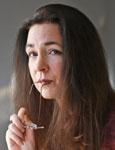I first met David McLimans the summer of 2001, on a blind date at the Greenbush Bar six weeks after my divorce was finished—done and dusted, as the Irish say—and six weeks before 9/11.
I had been told, somewhat misleadingly, that David was a commercial illustrator. The only commercial illustrator I’d ever known was a man in Connecticut who had drawn the image of Pepperidge Farm that now appears on all the Pepperidge Farm packages. I prepared myself for I don’t know what: someone more superficial, more garrulous, more commercial than the man I met.
David was handsome and shy, wearing ivory shorts, an ivory camp shirt, and German sandals, sitting at the bar with a beer: Madison was in a hot spell, yet there was something very cool about him even in the heat, a dashing dash of the spiritually self-exiled Green Bay lad. (Well, he was a silver fox and women were mad for him—not to put too fine a point on it.)
We found ourselves a table and more beer and spoke about being artists in Madison. I kept wondering why our paths had never crossed before (perhaps because we were both quasi-hermits, in our houses doing our work). He spoke of his appreciation of maps and postage stamps as aesthetic objects, of his time in the Navy, of his daughter, Hannah; the full range of his artistic talent and his deep, quick, offbeat sense of humor slowly began to reveal themselves.

That week I mailed him a book on cartography, a bunch of foreign stamps that had come in from European publishers, and a sheet of USPS special-issue illustrator stamps, asking him which illustrator he liked best. His choice was Rockwell Kent, who had illustrated Melville’s leviathan. Perhaps this was apt, given David’s history with sea creatures and boats and strong, figurative drawing.
On the morning of September 11th I was at David’s house—whose walls were hung with surprising, intricate art (his own)—and the phone rang. We turned on the television and spent the day dumbfounded. Disoriented from all directions that evening we still wanted to be together and stupidly thought we’d go to the movies—only to find every cinema in Madison closed. Not quite as a consequence (though we were both seeking comfort) for the next decade we remained more or less romantically involved. I was crazy about him. (“You’ve done well,” my mother said when she met David. A photo of him is still on her fridge and on mine as well.)
Despite the world news over those horrible Bush years—to which David’s art responded, in picture after picture—his house felt like a sanctuary; it’s proximity to the cemetery between Franklin Street and Speedway Road making it both peaceful and ironic, a source of comedy (“just catapult me in there from here,” he would say). David’s house continued to be a calming place: the main room taken up with its large desk in the alcove and the dining table too used for projects, its surface mottled with ink blots and paper cuttings; he was still not using the computer back then but making hand-cut collages that were picked up at day’s end by Fed Ex and sent to Harper’s, The Washington Post, The New York Times, whomever had commissioned them.

In the summers, if we had rented a lake house together, he combed the beaches for stones (including diamonds that the glacier or Capone might have left behind). David occasionally dumpster-dived, and on trash nights he strolled, alert and surveying, when people put their flotsam on the curb; he made sculpture from his plunder. Everything he did was done with great care and beauty: an ingeniously wrapped gift, an arrangement of wildflowers, a simple meal.
I had never met anyone with such a careful hand and sharp aesthetic eye in all that he did. I had once dated a painter who used to say, when cooking, “This may look like vomit but it’s going to be delicious.” Yet with David everything was exquisite from the start: a pizza with golden raisins resembled a rococo ceiling fresco. A meticulously chopped stir-fry or simple ad hoc salad with apples and basil (which I often still try to imitate) proved inimitable.
I saved every birthday or valentine card he ever made for me. In addition I have several beautiful black and white prints, a few collages, a sculpture of a bird made in part from a handyman’s level and the neck scroll of a violin, coffee mugs decorated with his distinctive primitive graphic—some drawn with a single line spinning maniacally around the cup.

For David, everything was full of music, pattern, motion: he often listened to jazz while working. (And going to hear jazz, especially when we travelled, was one of our great pleasures together.) David’s house had leaded glass windows, lending a graphic dimension to his rooms and to the views outside, some lost in the trees, like a tree fort.
And there is a way of looking at his artwork (especially that which he did for Patrick Flynn who commissioned from David illustrations for The Progressive, Rethinking Schools, and finally The Baffler) that imposes a window on the composition: something is looking in—poverty, war, ecological death—and other times someone is looking out: upon a classroom, a city, race relations, human or corporate activity. Visual puns abound. Even when handling bleak subjects there was often a liveliness to his work. His color scheme for a long spell utilized only what David called “true colors”—primary and secondary—a refusal to participate in the murk of mauve or smoky teal was his aesthetic (and he once painted his kitchen accordingly).
Master of the stark contrast and the tribal zig-zag, David loved reflections and reversals, yin and yang, and if dyslexia in artists is not a handicap but a gift, as many people now believe, he used his to great advantage and abandon, creating intricate patterns of mirrored reflections and flipped silhouettes. He incorporated typographic forms abstractly; yet from these he conjured pure, bold design.

From the beginning we had spoken of children’s books because David had a hankering to do one and was being encouraged by his friends. I had done a children’s book myself—a very unimpressive one—which I showed him, and I like to think its unimpressiveness helped inspire him.
Still, when I saw the first mock-up pages of Gone Wild: An Endangered Animal Alphabet I was astounded. He had taken his interest in typography and nature and wedded them in a stunningly original alphabet book about endangered animal species. I felt proud to know him and said so. I put him in touch with my literary agent, who sold the book to a small imprint called Walker Books, and when Gone Wild was published and then selected by The New York Society of Illustrators as one of their books of the year we went to New York to see the exhibit there. Looking around I knew, and said to David, that there was nothing as remotely good as his book in the whole place and that he was going to win a Caldecott, one of the most prestigious children’s book awards.
“Don’t jinx it,” he said.
“OK,” I said, “You’re going to win a teeny tiny little hardly anything.”
The New York Times listed Gone Wild as one of the ten best illustrated books of the year. And in January 2007 the Association for Library Service to Children awarded David with one of their two Caldecott Honors. We went to Washington DC in the spring for the ceremony, and, when his name was announced, David hilariously leapt in a single bound onto the stage, directly from the floor, showing off his springy knees and general spryness: he was a little self-conscious about being the oldest author there and wanted to show off a little.
To me he seemed eternal.

David went on to do more picture books, all of them beautiful, and the second one, Gone Fishing, he dedicated to my son, Ben (Gone Wild was dedicated to Hannah).
David was great with kids, full of physical and verbal comedy—he would make a quip then take a pratfall—and his books were all dedicated to the children he knew best. He had started to become a popular visitor to schools and children’s museums. He produced three children’s books in all but he had several ideas for others, including an amazing one in draft called “The Big House” (inspired somewhat by his father’s work in prison) which was begun long ago but never completed.
At its end our relationship loitered near various permutations of friendship. The afternoon he died, we had been e-mailing in the morning. I was teaching in Tennessee. Time had flown, happily and unhappily: I had attended his daughter’s high school graduation, then her college graduation; he had watched ten years of my son’s soccer games in both local and faraway parks. What he sent me that morning were the Harper’s illustrations he’d done for a book review of Elizabeth Kolbert’s The Sixth Extinction: An Unnatural History. They were intricate map collages of animal skulls, each one a seer’s face of precise environmental catastrophe peering in at the windows.
They made his death later that day all that much more unbelievable.





